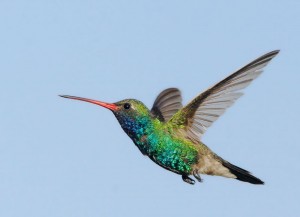Hummingbird
Broad-billed Hummingbird (Cyanthus latirostris) Photo by Tom Grey
Although the hummingbird is tiny, it exhibits prodigious feats. In order to hover at a nectar-producing flower, its wings beat typically 50-80 times per second, its heart beats up to 1250 beats per minute, its breathing rate is 250 breaths per minute. They visit hundreds of flowers a day to acquire just enough energy to survive overnight. During the summer in North America they must add enough fat reserves to sustain them during migration flights across the Gulf of Mexico to wintering sites in Central America or Mexico. Ten different types visit Kansas including the Broad-billed hummingbird shown in the photo above. Hummingbirds co-evolved with specific flowers that are only pollinated by birds with long slender beaks that can reach the narrow tubular flower structures containing nectar. These structures ensure contact between the pollinating hummingbird and the stamen and stigma that results in pollination. Hummingbirds are extinct everywhere except the Americas. Their nests are also tiny and often have bits of lichen attached to them.

